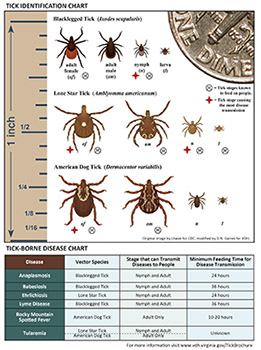There are the three tick species commonly found in Fairfax County that can spread disease to humans.

Blacklegged or Deer Tick (Ixodes scapularis)
Unfed female blacklegged ticks have a reddish body and a dark brown area located behind the head. Females are approximately 1/8 inch long. Male blacklegged ticks, which are dark brown in color, are slightly shorter in length. Blacklegged tick nymphs are approximately 1/16 inch long and will feed on humans, other mammals or birds. Adult blacklegged ticks prefer to feed on white-tailed deer although they will feed on a variety of mammals and birds. Blacklegged ticks can spread Lyme disease, anaplasmosis and Powassan virus.
Lone Star Tick (Amblyomma americanum)
The Lone Star tick is the most commonly found tick in Fairfax County. It gets its common name from a characteristic white or yellowish spot on the middle of the back of the adult female Lone Star tick. Both males and females are reddish brown in color and between 1/8 and 1/4 inch long, but male Lone Star ticks do not have the spot. Reddish-brown Lone Star nymphs are approximately 1/16 inch long. Tularemia and Ehrlichiosis are transmitted by this species. The Lone Star tick does not transmit Lyme disease. Lone Star ticks will feed on most mammals.
American Dog Tick (Dermacentor variabilis)
Adult American dog ticks are brown and are almost 1/4 inch long. They can be distinguished from deer ticks by their size and the presence of off-white colored markings on their backs. Dogs are one of the preferred hosts of adult American dog ticks but they will feed on other medium to large mammals including humans. The immature stages feed on small mammals. The American dog tick transmits Rocky Mountain spotted fever and tularemia.
Resources
- Ticks and Tick Bite Prevention
- Lyme Disease and Other Diseases Spread by Ticks
- Free Tick Identification Service
- Life Cycle of Hard Ticks That Spread Disease - Centers for Disease Control and Prevention (CDC)
- Geographical Distribution of Ticks That Bite Humans - CDC

